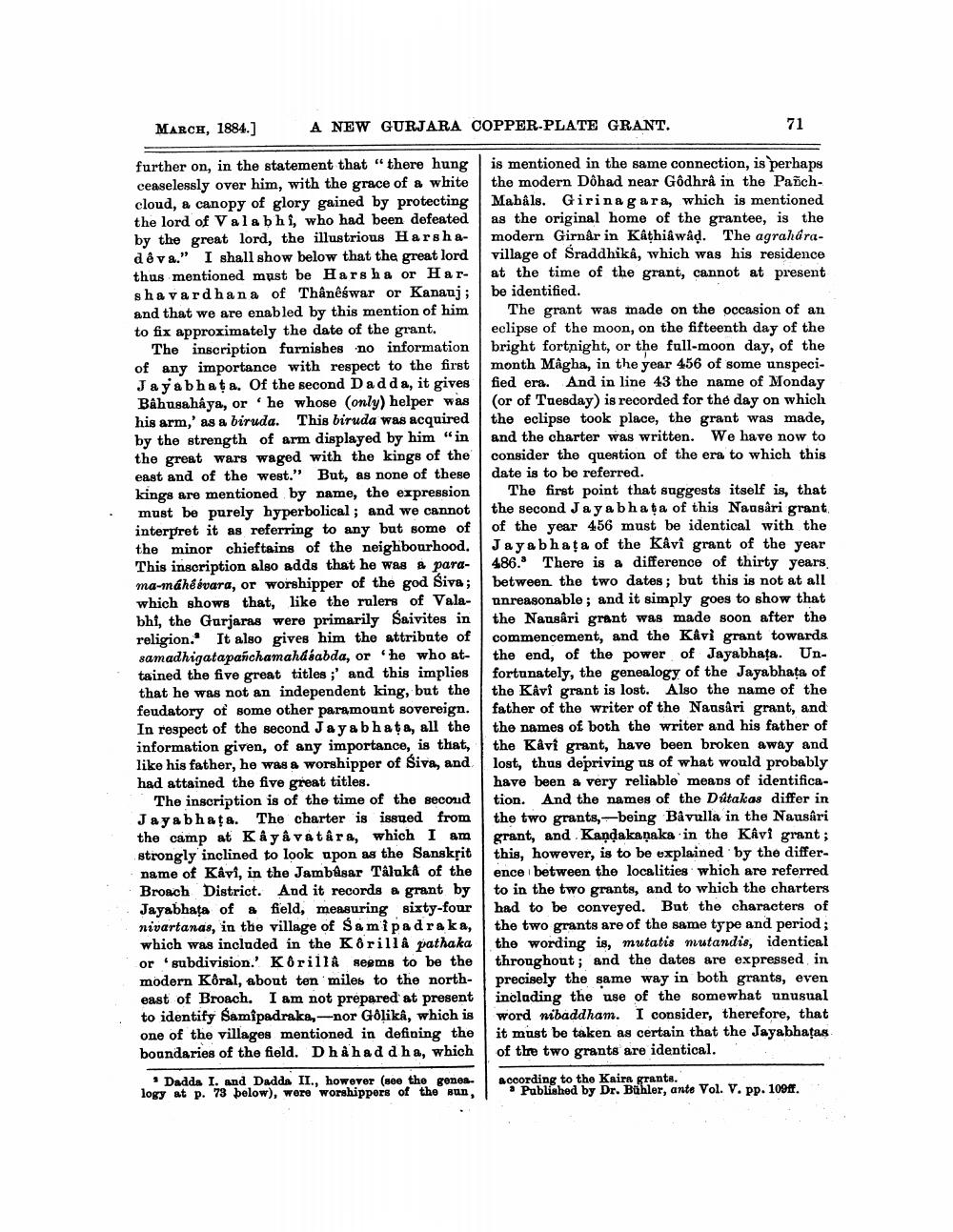________________
A NEW GURJARA COPPER-PLATE GRANT.
MARCH, 1884.]
further on, in the statement that "there hung ceaselessly over him, with the grace of a white cloud, a canopy of glory gained by protecting the lord of Valabhi, who had been defeated by the great lord, the illustrious Harshadêva." I shall show below that the great lord thus mentioned must be Harsha or Harshavardhana of Thânêśwar or Kanauj; and that we are enabled by this mention of him to fix approximately the date of the grant.
The inscription furnishes no information of any importance with respect to the first Jayabhata. Of the second Dadda, it gives Bâhusahaya, or he whose (only) helper was his arm,' as a biruda. This biruda was acquired by the strength of arm displayed by him "in the great wars waged with the kings of the east and of the west." But, as none of these kings are mentioned by name, the expression must be purely hyperbolical; and we cannot interpret it as referring to any but some of the minor chieftains of the neighbourhood. This inscription also adds that he was a parama-máhéévara, or worshipper of the god Siva; which shows that, like the rulers of Valabhi, the Gurjaras were primarily Saivites in religion. It also gives him the attribute of samadhigatapanchamahásabda, or he who attained the five great titles;' and this implies that he was not an independent king, but the feudatory of some other paramount sovereign. In respect of the second Jayabhata, all the information given, of any importance, is that, like his father, he was a worshipper of Śiva, and had attained the five great titles.
The inscription is of the time of the second Jayabhata. The charter is issued from the camp at Kâyâvatâra, which I am strongly inclined to look upon as the Sanskrit name of Kâvi, in the Jambâsar Taluk of the Broach District. And it records a grant by Jayabhata of a field, measuring sixty-four nivartanas, in the village of Sami padraka, which was included in the Kôrillâ pathaka or subdivision.' Kôrillâ seems to be the modern Koral, about ten miles to the northeast of Broach. I am not prepared at present to identify Samipadraka,-nor Gôlikâ, which is one of the villages mentioned in defining the boundaries of the field. Dha haddha, which
Dadda I. and Dadda II., however (see the genes. logy at p. 73 below), were worshippers of the sun,
71
is mentioned in the same connection, is perhaps the modern Dôhad near Gôdhrâ in the PañchMahâls. Girinagara, which is mentioned as the original home of the grantee, is the modern Girnår in Kâthiâwâḍ. The agraharavillage of Sraddhikâ, which was his residence at the time of the grant, cannot at present be identified.
The grant was made on the occasion of an eclipse of the moon, on the fifteenth day of the bright fortnight, or the full-moon day, of the month Mâgha, in the year 456 of some unspecified era. And in line 43 the name of Monday (or of Tuesday) is recorded for the day on which the eclipse took place, the grant was made, and the charter was written. We have now to consider the question of the era to which this date is to be referred.
The first point that suggests itself is, that the second Jayabhata of this Nausâri grant of the year 456 must be identical with the Jayabhata of the Kâvi grant of the year 486. There is a difference of thirty years. between the two dates; but this is not at all unreasonable; and it simply goes to show that the Nausâri grant was made soon after the commencement, and the Kâvi grant towards the end, of the power of Jayabhata. Unfortunately, the genealogy of the Jayabhata of the Kavi grant is lost. Also the name of the father of the writer of the Nausâri grant, and the names of both the writer and his father of the Kâvi grant, have been broken away and lost, thus depriving us of what would probably have been a very reliable means of identification. And the names of the Dutakas differ in the two grants,-being Bâvulla in the Nausâri grant, and Kandakanaka in the Kâvi grant; this, however, is to be explained by the difference between the localities which are referred to in the two grants, and to which the charters had to be conveyed. But the characters of the two grants are of the same type and period; the wording is, mutatis mutandis, identical throughout; and the dates are expressed in precisely the same way in both grants, even including the use of the somewhat unusual word nibaddham. I consider, therefore, that it must be taken as certain that the Jayabhatas of the two grants are identical.
according to the Kaira grants.
Published by Dr. Bühler, ante Vol. V. pp. 109ff.




